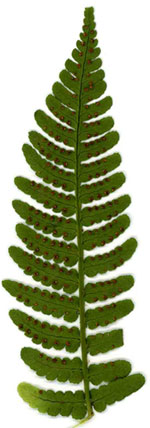| Dryopteris marginalis | ||
Marginal wood fern | ||
|
Etymology
Marginalis means margined, referring to the position of the sori.
Description
Rhizome: erect, soft, brown, chaffy scales.
Frond: 70 cm high by 20 cm wide, evergreen, monomorphic, blade/stipe ratio: 2:1 to 3:1. Stipe: grooved, reddish brown at swollen base, becoming brownish green above, scaly at base; scales in dense tuft, pale tawny, vascular bundles: 7 in a c-shaped arc, sometimes fewer at the stipe apex. Blade: 2-pinnate, ovate-lanceolate, leathery, deep green to felty blue-green, linear to ovate scales below, absent above. Pinnae: 12 to 16 pair, in plane of blade, lanceolate; basal pinnae slightly reduced; pinnules basal pinnules longer than adjacent pinnules, basal basiscopic pinnule longer than basal acroscopic pinnule; costae grooved above, continuous from rachis to costae; margins shallowly crenate to nearly entire; veins free, forked. Sori: round, in 1 row near the margin on the top two-thirds of the blade, indusium: reniform, silvery, attached at a sinus, sporangia: lead gray, then maturing to dark brown, maturity: midsummer. Culture
Habitat: rocky, wooded slopes and ravines, edges of woods, stream banks and roadbanks, and rock walls .
Distribution: eastern North America, southern tip of Greenland.
Hardy to -40�C, USDA Zone 2.
Distinctive Characteristics
sori neatly arranged along the margins
Synonyms
Polypodium marginale L. Aspidium filix-mas var. marginale Chr. Filix-Mas marginalis Farwell Lastrea marginalis Presl Nephrodium marginale Michx. Polystichum marginale Keys. Thelypteris marginalis Nieuwl. |
|
|

Dryopteris marginalis. Seven vascular bundles at the stipe base, the same or fewer at the top of the stipe. �Drawing from Ferns of Northeastern United States, Farida A. Wiley, 1936. |

Dryopteris marginalis. Fertile pinna, mid-blade, early August. Click through for details. Sori are marginal except when the margin is incised: position is at base of sinus. �Scan: Tom Stuart |

Dryopteris marginalis. a) fronds, fertile on upper portion; b) pinnule with marginal sori . �Illustration by V. Fulford from Ferns and Fern Allies of Canada, William J. Cody and Donald M. Britton, 1989, � Agriculture Canada, used with permission. |
